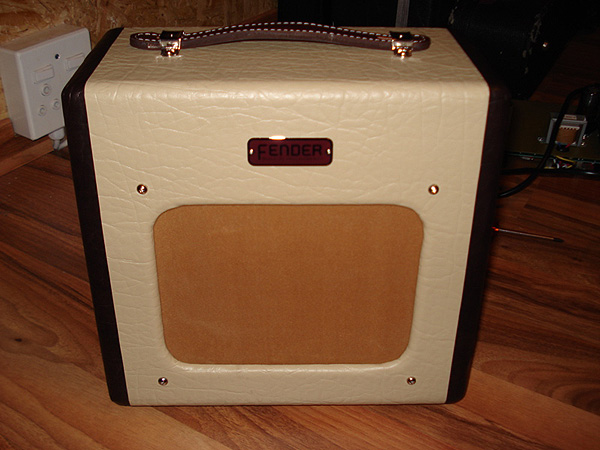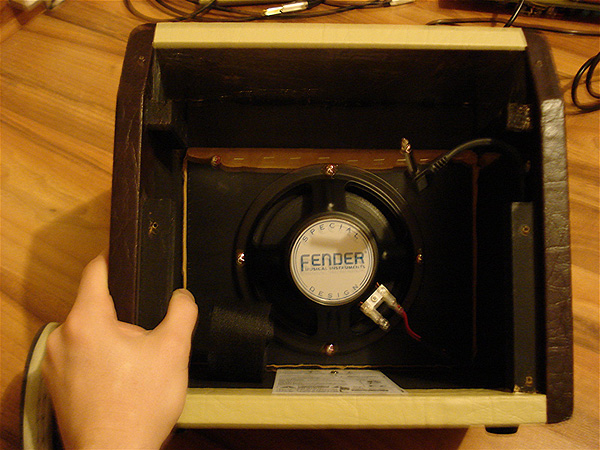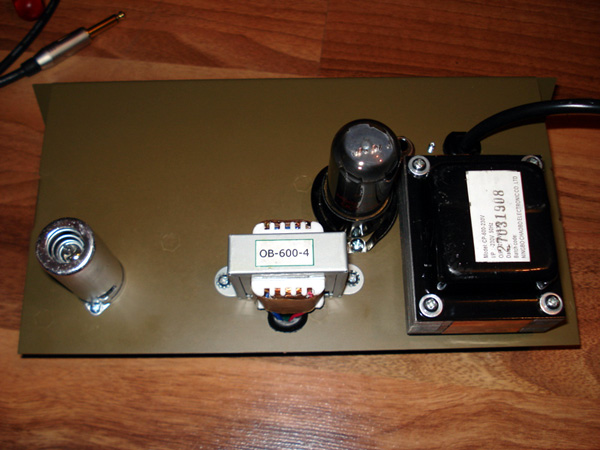matta
Well-known member
Hey Guys,
For the longest time I've wanted to build a little low wattage Valve/Tube amp for recording and had my sights set on building a little Fender Champ, the 5F1 version, but being on the butt end of Africa made sourcing parts difficult and fairly costly and so I abandoned the idea... until January '07 when Fender announced this little guy.
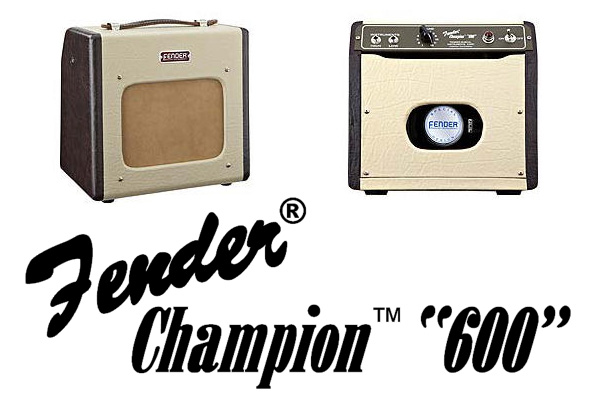
Not only did it look great, but sounded great (from clips I'd heard) and was a sleeper at the price (under $200!) Costs were kept down being built in China and I guess is Fenders answer to Epiphone's low cost Valve Jr.
I thought the worst that could/would happen is I buy it and it sucked but am left with killer chassis and cabinet to build my own Champ in.... I wasn't at all disappointed though!
The amp itself is pretty amazing, esp. for the price though I think would benefit greatly from upgrading the stock valves from the no name 'chinese jobbies' to a nice set of JJ Tesla's and replacing the cheap speaker with a Weber or Jensen which I plan to do in time.... also could drop a Hammond or Mercury output trafo...
Being the inquisitive guy I am I rushed back after buying it and took it all apart, shot a few pics and then went about retracing the circuit... low and behold found it is isn't the old Champion circuit at all but a pretty much PART FOR PART clone of the 'Black Face' era Champ using the AA764 circuit!
Here are a few pics of the guts.
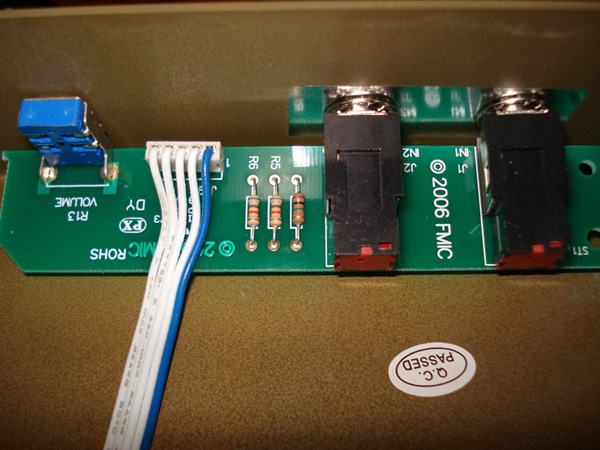
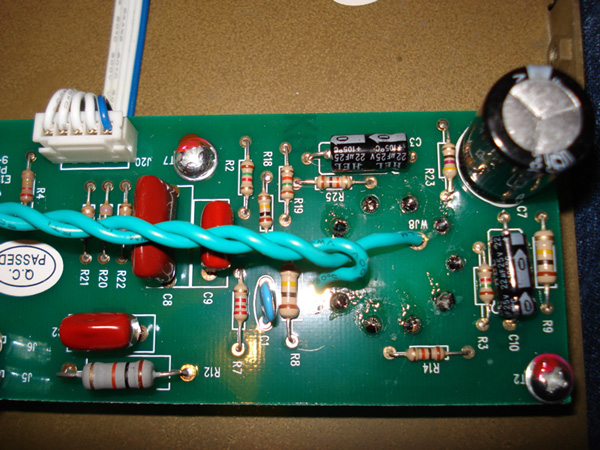
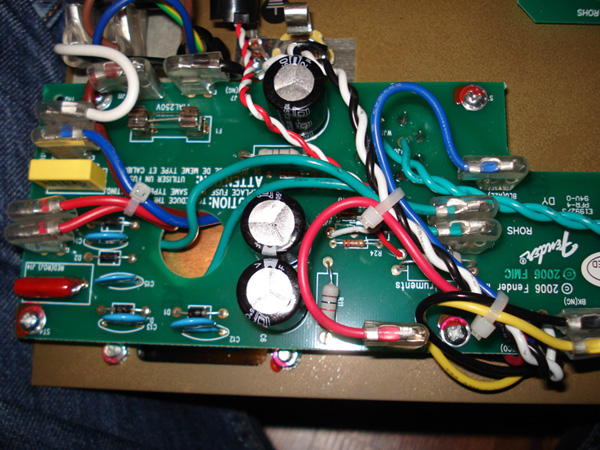
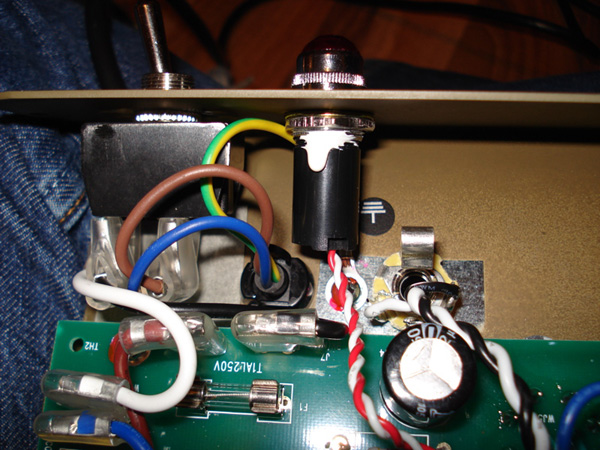
I've uploaded the SCHEMATIC with the redrawn values on it and it can be found here:
http://www.matt-allison.com/diy/fender/champion-600-schemo.gif
Where it differs from the original 'Black Face' is that it has a solid state power supply, (which I've not redrawn), the power transformer lacks a center tap but has the 2 x 100R virtual center tap trick to mimic it, it also has a fixed tone stack unlike the original Black Face that had separate Treble and Bass controls. It also features a custom built 6 inch speaker where the original had an 8 inch one.
Now I'm kind of new to Valves/Tubes and the only other piece I own is an LA-2A I built a few months ago so my understanding of valves and their inner workings is limited and I'm hoping those with more experience will try open this up for me and expound on a few things.
I'd like to investigate some mods one of which may be to remove the fixed tone stack and replace it with 2 small panel mounted pots and reclaim the TREBLE and BASS controls, the other may be to lift the tone stack all together, which I've read may increase the gain/output level.
What I am wondering about though as well is the choice or values of the resistors, in the original you had 2 x 250K pots with the Bass pot having a 15K to ground, now in this unit they are fixed at 75K but the 15K is now 180K! Why the huge jump?
It has quite a bit of hum on it which I'd like to reduce and I seem to recall Analogpackrat saying something about putting a cap and resistor before the output transformer to reduce it???
Also wondering why they added the extra 470R/1W resistor onto pin 4 of the 6V6? What is it's role there?
Thanks in advance for any suggestions or help.
Cheers
Matt
For the longest time I've wanted to build a little low wattage Valve/Tube amp for recording and had my sights set on building a little Fender Champ, the 5F1 version, but being on the butt end of Africa made sourcing parts difficult and fairly costly and so I abandoned the idea... until January '07 when Fender announced this little guy.

Not only did it look great, but sounded great (from clips I'd heard) and was a sleeper at the price (under $200!) Costs were kept down being built in China and I guess is Fenders answer to Epiphone's low cost Valve Jr.
I thought the worst that could/would happen is I buy it and it sucked but am left with killer chassis and cabinet to build my own Champ in.... I wasn't at all disappointed though!
The amp itself is pretty amazing, esp. for the price though I think would benefit greatly from upgrading the stock valves from the no name 'chinese jobbies' to a nice set of JJ Tesla's and replacing the cheap speaker with a Weber or Jensen which I plan to do in time.... also could drop a Hammond or Mercury output trafo...
Being the inquisitive guy I am I rushed back after buying it and took it all apart, shot a few pics and then went about retracing the circuit... low and behold found it is isn't the old Champion circuit at all but a pretty much PART FOR PART clone of the 'Black Face' era Champ using the AA764 circuit!
Here are a few pics of the guts.




I've uploaded the SCHEMATIC with the redrawn values on it and it can be found here:
http://www.matt-allison.com/diy/fender/champion-600-schemo.gif
Where it differs from the original 'Black Face' is that it has a solid state power supply, (which I've not redrawn), the power transformer lacks a center tap but has the 2 x 100R virtual center tap trick to mimic it, it also has a fixed tone stack unlike the original Black Face that had separate Treble and Bass controls. It also features a custom built 6 inch speaker where the original had an 8 inch one.
Now I'm kind of new to Valves/Tubes and the only other piece I own is an LA-2A I built a few months ago so my understanding of valves and their inner workings is limited and I'm hoping those with more experience will try open this up for me and expound on a few things.
I'd like to investigate some mods one of which may be to remove the fixed tone stack and replace it with 2 small panel mounted pots and reclaim the TREBLE and BASS controls, the other may be to lift the tone stack all together, which I've read may increase the gain/output level.
What I am wondering about though as well is the choice or values of the resistors, in the original you had 2 x 250K pots with the Bass pot having a 15K to ground, now in this unit they are fixed at 75K but the 15K is now 180K! Why the huge jump?
It has quite a bit of hum on it which I'd like to reduce and I seem to recall Analogpackrat saying something about putting a cap and resistor before the output transformer to reduce it???
Also wondering why they added the extra 470R/1W resistor onto pin 4 of the 6V6? What is it's role there?
Thanks in advance for any suggestions or help.
Cheers
Matt



